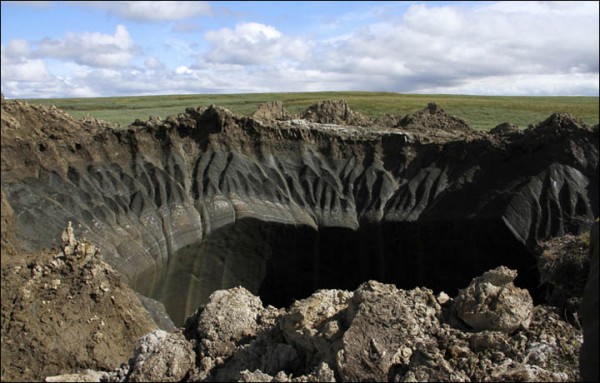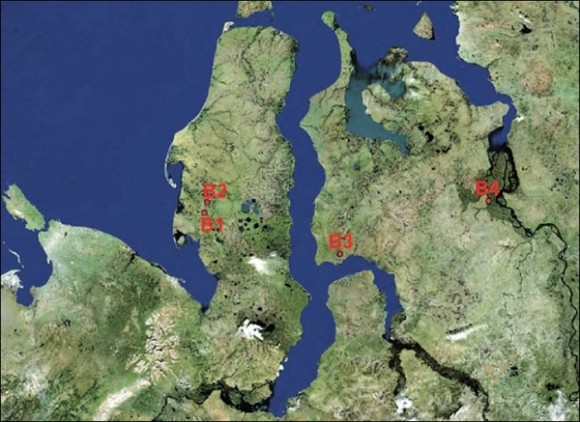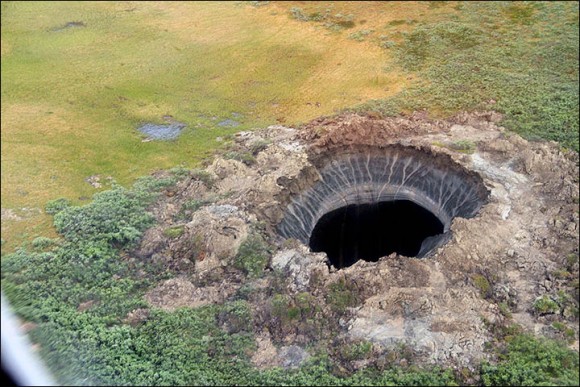
In mid-July 2014, a mysterious hole in permafrost, spotted by helicopter pilots in the Yamal region of northern Russia, captured the world’s attention. Reindeer herders reported a second hole some days later, and still later a third Siberian crater was found. Weird explanations ranged from meteorites to stray missiles to aliens, but by late July a team of scientists reported that they had measured unusually high concentrations of methane inside the first crater, which is now known as B1. The journal Nature published a story on its website on July 31, 2014 featuring those findings, and many accepted the unsettling idea that an explosive release of methane, related to global warming, caused the craters … until February 2015 when the Siberian Times reported more craters in Siberia. A Russian scientist speculated that there may be “20 to 30 craters more.” The report of more craters has led scientists to offer a different, simpler explanation for them, one that is still related to global warming, but does not involve a powerful and explosive methane release.
Siberian Times wrote on February 23, 2015 that:
Examination using satellite images has helped Russian experts understand that the craters are more widespread than was first realized, with one large hole surrounded by as many as 20 mini-craters …
Moscow scientist Vasily Bogoyavlensky – deputy director of the Moscow-based Oil and Gas Research Institute, part of the Russian Academy of Sciences – called for “urgent investigation” of the craters. He was quoted in Siberian Times as saying:
We know now of seven craters in the Arctic area. Five are directly on the Yamal peninsula, one in Yamal Autonomous district, and one is on the north of the Krasnoyarsk region, near the Taimyr peninsula.
We have exact locations for only four of them. The other three were spotted by reindeer herders. But I am sure that there are more craters on Yamal, we just need to search for them … I suppose there could be 20 to 30 craters more.
Enjoying EarthSky so far? Sign up for our free daily newsletter today!


Carolyn Ruppel, chief of the U.S. Geological Survey’s Gas Hydrates Project, told EarthSky this week (March 9, 2015) that an explosive release of methane is not a likely explanation for the craters. It’s true that, in Siberian permafrost, large deposits of methane gas are trapped in ice, forming what is called a gas hydrate. Methane remains stable and frozen at certain temperatures, but as the permafrost warms, and its internal strength decreases, it may be less able to withhold the build-up of sub-surface gases, and thus a release of methane is possible.
But, Ruppel told us:
Generic methane hydrates in permafrost settings are normally not stable above about 200 meters depth. The craters are far shallower than that, so tapping into dissociating methane hydrate is probably unlikely.
She and other scientists are calling on a simpler explanation, related to mounds of earth-covered ice in the Arctic and subarctic known as pingos.
National Geographic reported on February 27:
A pingo is a plug of ice that forms near the surface over time and has a small mound or hill on top.
When an ice plug melts rapidly — as many have been, thanks to unseasonably warm temperatures in Siberia over the past year — it can cause part of the ground to collapse, forming a crater.
That can’t be the whole story, since ejected rocks that have been found around the rim of the craters, suggesting some sort of explosion.

Plus, if explosive methane release is not the reason for the craters – as reported last summer – what can account for the unusually high concentrations of methane reported with the first crater, B1? Carolyn Ruppel told EarthSky:
This part of Siberia does have a lot of methane in terms of underlying conventional gas deposits. So it is possible that these craters are somehow tapping into some migration pathway for those gas deposits…
More generically, permafrost and thawing permafrost are sometimes associated with significant methane. Methane can be trapped as free gas in permafrost for a long time. Gas ‘kicks’ have been observed in relatively shallow boreholes in the Yamal Peninsula in the past, and these are not an unusual occurrence in such settings. Furthermore, thawing permafrost makes carbon bioavailable to microbes that can then produce methane.
So finding methane in these settings is not too big a surprise.
She said rocks may have been ejected upward when methane-containing natural gas – stored in the permafrost but kept under pressure by the weight of the pingos – suddenly released in the warmer temperatures as the pingos collapsed and made the craters. That’s a less dramatic scenario than the original idea, which was that methane in and of itself exploded upward forcefully enough to create the giant holes.


Last summer, when the first crater was found, the University of Stockholm had just reported what it called “vast methane plumes” escaping from the floor of the Arctic Ocean. They were found by scientists aboard the icebreaker Oden, which was in the Arctic exploring and measuring methane release from the seafloor.
Read more: Scientists discover vast methane plumes escaping from Arctic seafloor
Methane, as you may know, is a powerful greenhouse gas, more powerful than carbon dioxide. It has the potential to accelerate global warming rapidly via a feedback loop. In other words, scientists have said, as climate warms, methane is being released into the atmosphere both from permafrost and from the Arctic seafloor. This expelled methane increases temperatures more rapidly than carbon dioxide would by itself. The warmer temperatures cause more methane to be released and thus more warming; hence, the feedback loop.
That potential has not gone away. But, in the midst of thinking about that possibility, the news that giant holes in Siberian permafrost are not being blasted out by an explosive methane release is comforting.


Bottom line: Siberian Times reported a total of seven mystery craters in Siberia in February 2015, with one scientist speculating on the possibility of “20-30 more.” Meanwhile, other scientists are suggesting that the craters are formed not by explosive methane release, as was previously suggested, but by another, less dramatic mechanism, the rapid melting of ice plugs known as pingos, due to unseasonably warm temperatures in Siberia over the past year.











